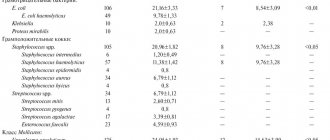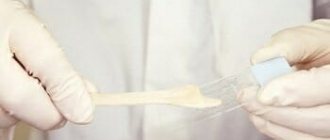Chlamydia is a group of infectious diseases caused by chlamydia. Depending on the type of chlamydia, they can affect the organs of the cardiovascular system, respiratory organs, bones and joints, and visual organs. But most often chlamydia has a urogenital form and is localized on the mucous membrane of the urethra in men. In the absence of therapy, chlamydia moves and parasitizes in other organs of the reproductive system: prostate gland, epididymis, seminal vesicles.
Features of the course of chlamydia in men
Chlamydia may not appear at all for a long time or may have scant symptoms, which are most often ignored. The incubation period of the disease can range from 5 to 28 days.
The development of chlamydia is accompanied by minor inflammation of the urethra, which causes urethritis. There are usually no special symptoms indicating the presence of pathogenic microorganisms.
General symptoms include the following:
- morning glassy discharge in the form of a drop;
- discomfort when urinating, accompanied by itching or burning;
- mild pain in the urethra, testicles, anus, scrotum;
- swelling, redness of the external opening of the urethra;
- cloudy urine;
- discharge of blood in urine or semen;
- problems with erection.
After several months from the onset of infection, the symptoms of chlamydia may subside, however, microorganisms continue to actively reproduce on the mucous membranes. Men most often seek help from a doctor when there are symptoms of prostatitis, vesiculitis, epididymitis or orchitis that occur as a result of the disease.
How to test for chlamydia in women
How to get tested for chlamydia in women
The technique for collecting material for examination involves scraping from the cervical canal with a special spoon or cytobrush with preliminary removal of secretions and mucus.
Chlamydia smears are not taken from women during menstruation.
Your task is to properly prepare for the examination:
- Avoid sexual intercourse 2-3 days before the test.
- If you are taking antibiotics (or antimicrobial agents), then you can undergo a PCR examination only 3 weeks after the end of the course of treatment.
- A few days before the analysis, hygiene of the external genitalia should be carried out only with water.
Both soap and any intimate gels and sprays, especially those with an antibacterial effect, are excluded.
- 3 days before the test there should be no: examination by a gynecologist, transvaginal ultrasound, diagnostic gynecological procedures (vacuum, placement/removal of the IUD, colposcopy, etc.).
- Immediately before the procedure, you should not urinate for 1.5-2 hours.
The analysis is completed quite quickly - 1-2 days.
You always get an unambiguous result: PCR for chlamydia is either negative or positive.
Negative – there is no disease.
Positive – there is a pathogen in the body, so you need to see a doctor for treatment.
When are women tested for chlamydia after infection?
Let's look at when, after infection, you should get tested for chlamydia.
Each infection has its own incubation period.
It is after this period has passed that signs of infection can be detected.
Important! A test for chlamydia should be taken no earlier than 2 weeks after the suspected infection.
If you suspect that you are infected and want to take action earlier than this, you should carry out emergency prevention.
These activities are carried out by a doctor in a medical office.
Self-prevention with antiseptics is usually ineffective.
Which doctor prescribes a test for chlamydia in women.
Patients often ask: “Which doctor should I contact if I suspect an infection?”
The following doctors can prescribe tests for chlamydia:
- Gynecologist;
- Urologist;
- Venereologist.
It is these specialists who diagnose and treat sexually transmitted diseases.
PCR swab analysis
Let's take a closer look at how PCR tests for chlamydia are performed.
As you know, this technique is quite modern, and allows you to detect even the smallest amount of microorganisms in the blood.
If primary diagnosis is needed, a qualitative PCR analysis is performed.
During control tests, and in order to determine the dynamics of the process, the doctor prescribes a study using a quantitative method.
In this case, it will be clear how the disease progresses and whether the treatment is correct.
Any biological fluid is suitable for PCR.
It is advisable to perform the analysis using a smear.
The material for the study is taken from various locations.
It depends on the clinical picture of the disease and symptoms.
The doctor may take a swab from the following places:
- Oral cavity;
- Anus and perianal folds;
- Genitourinary organs;
- Conjunctiva.
Let us examine in more detail the methods of collecting a smear from the anus, mouth and eyes.
PCR swab from the anus
If you need to test for chlamydia in women, the doctor often prescribes sampling material from the anus.
Infection can occur if a woman has anal sex without a condom.
The smear is taken with a special probe or a cotton swab.
The resulting material is sent to the laboratory, where it is examined using the PCR method.
PCR swab from the mouth for chlamydia in women
If the doctor notices an infectious process in the oral cavity that is suspicious for chlamydia infection, he will prescribe a collection of material.
Remember! There is a risk of infection through the oral cavity through oral contact.
You should not allow unprotected oral sex with an untested partner.
This smear is carried out with a long stick with a cotton ball at the end.
For the correct result, it is important to take a smear from the tonsils, palatine arches and possible inflammatory elements that are present in the oral cavity.
The resulting material is immediately placed in a special environment and sent to the laboratory for research.
PCR swab from the eyes for chlamydia
Often chlamydia gives the picture of conjunctivitis.
If a doctor notices a similar process in a woman, he will recommend a smear from the conjunctiva.
The doctor will carefully take the material for the smear using a cotton swab.
The result of the PCR smear will be ready quite quickly.
This will confirm the diagnosis and prescribe treatment without delay.
The types of immunoglobulins in the blood during analysis will help determine the stage of the disease and the duration of infection.
Analysis for chlamydia in women: culture for sensitivity
If it is necessary to select an antibiotic to treat chlamydia, a culture is performed.
This study is carried out using the bacteriological method.
In this case, the material is planted on a special nutrient medium.
Incubate in an autoclave at a certain temperature.
After several days of maintaining the optimal temperature, bacterial growth is obtained.
To determine sensitivity to antibacterial drugs, special plates are applied to the medium.
They are impregnated with the appropriate antibiotic.
If no growth is observed around the plug, this means good sensitivity to this drug.
Seeding may take a long time.
The minimum completion time is 5-7 days upon receipt of a positive result.
A negative result can be seen after 3 days.
If you need to have a chlamydia culture done, the fastest way to do this is in the laboratory of our specialized clinic.
Analysis for chlamydia in women: comparison of the effectiveness of methods
We have described several methods that can be used to diagnose chlamydia.
Patients often ask: “Which method is more effective?”
What test is best to take for a reliable diagnosis?
The fact is that each method has its own advantages and disadvantages.
In each specific case, the doctor selects an individual examination plan that will help in diagnosing the disease.
Many people are interested in the question of which test is better to take, blood or smear.
Clearly, ELISA diagnosis does not always give an accurate answer to the question of whether there is chlamydia.
Only in the absence of all types of antibodies can we say that there is no chlamydia.
Other results require further examination using PCR.

PCR diagnostics are also used as a control after treatment of chlamydia.
Let's compare PCR, ELISA and Bacteriological method.
PCR is considered the most accurate, modern and fastest method for diagnosing chlamydia.
The advantages are that the results are obtained in almost 20-30 minutes, the number of false positive conclusions is minimal.
ELISA diagnostics is prescribed if it is important to understand when the disease began and what stage it is at.
This research method is more difficult to decipher.
The results may be mixed.
The longest research method is bacterial culture.
It is a classic technique that has been used for many years.
In controversial cases, it is culture that allows confirming the diagnosis and identifying the sensitivity of microorganisms to drugs.
Often the listed methods complement each other.
Deciphering the analysis for chlamydia in women
Once you have received the test, you should under no circumstances make a diagnosis yourself.
Decoding the tests is solely the prerogative of the doctor.
The easiest way to decipher the PCR analysis.
The form usually indicates whether it is positive or negative.
If you took a bacteriological culture test, the form will have quite a lot of lines.
They will indicate whether there is sensitivity to certain antibiotics.
Modern laboratories usually designate sensitivity using 3 letters.
How to decipher them?
It's pretty simple:
- Sensitive - S or H;
- Moderately sensitive – I;
- Resistant or stable – R or U.
Sometimes the abbreviation “HF” is written, which means high sensitivity.
Some laboratories designate sensitivity as a plus.
The bacterial culture will indicate the strain variety and the number of bacteria.
Deciphering the ELISA analysis is quite difficult.
As a rule, the form will indicate the presence of several types of antibodies.
Test for chlamydia in women: PCR with concentration
Concentration analysis or quantitative PCR technique is a more accurate method of research than a qualitative method.
It is used to monitor the treatment performed.
The doctor compares the titers and makes a conclusion about the effectiveness.
When can women get smears and blood tests for chlamydia after antibiotics?
A post-treatment follow-up test is usually taken 2-4 weeks after completing the medications.
This time is needed to eliminate false results.
Tests are usually taken three times to reliably verify the absence of infection.
False-positive test for chlamydia in women
This result is quite rare.
The main reason may be an incorrectly chosen research methodology.
For example, performing high-quality PCR after antibiotic treatment can give a false positive result.
False negative test for chlamydia in women
This result occurs in a small percentage of cases.
As a rule, it is associated with incorrect smear collection technique.
There may be a violation of sterility or analysis technology.
Attention! To avoid false results, you should contact a reputable laboratory.
Where can you get tested for chlamydia in women?
A test for chlamydia can be taken at a paid medical institution.
In public clinics, such diagnostic measures are rarely performed.
If you want to take a test under compulsory medical insurance, most often you will be sent to the district police department.
You can get tested for chlamydia in women quickly and efficiently in our medical center.
If you need to properly test for chlamydia in women, contact the author of this article - a venereologist, a urologist in Moscow with 15 years of experience.
Methods for diagnostic testing of chlamydia in men
A urologist or andrologist prescribes the following types of studies:
Laboratory tests play an important role in diagnosing chlamydia, since the disease is secretive and asymptomatic. The main diagnostic methods are:
- PCR diagnostics, during which the DNA of the pathogen is determined;
- enzyme immunoassay is carried out to detect antibodies in venous blood;
- bacteriological culture of a smear from the urethra to detect microorganisms;
- cystoscopy of scrapings from the urethra and prostate secretion is performed in case of acute disease;
- express test - is the fastest way to determine the pathogen using special test systems;
- Additionally, if the development of an inflammatory process of the genitourinary system is suspected, the following may be prescribed: general blood tests, urine tests, and ultrasound.
Donation of venous blood should be done on an empty stomach, and before taking a urine test, smear and scraping from the urethra, you must abstain from sexual intercourse for several days and not take antibiotics. A few hours before the planned delivery, it is recommended to refrain from visiting the toilet.
Chlamydia trachomatis, DNA [real-time PCR]
A study to identify the causative agent of urogenital chlamydia (Chlamydia trachomatis), during which the genetic material (DNA) of chlamydia in a sample of biomaterial is determined using the real-time polymerase chain reaction (RT-PCR) method.
Synonyms Russian
Chlamydia, the causative agent of chlamydia.
English synonyms
Ch. trachomatis, DNA (qPCR, Real-time PCR, RT-PCR), Chlamydia trachomatis by Amplified Detection.
Research method
Real-time polymerase chain reaction (PCR).
What biomaterial can be used for research?
Conjunctival discharge, prostate secretion, first portion of morning urine, rectal scraping, synovial fluid, urogenital scraping, ejaculate, throat (oropharynx) swab.
General information about the study
Chlamydia trachomatis (chlamydia trachomatis) is a bacterium, an intracellular parasite, the causative agent of several human diseases. In particular, some serovars of this species cause trachoma and lymphogranuloma venereum. In Russia, the most common chlamydial infection of the genitourinary system (urogenital chlamydia). It is transmitted sexually, as well as from mother to child during childbirth. Contact-household transmission is also possible. Chlamydia trachomatis is the most common causative agent of nongonococcal urethritis. Chlamydia is more common in women than in men.
The incubation period ranges from 2 weeks to 1 month. Often (in about half of the cases) chlamydia is asymptomatic.
Initial symptoms of infection: burning and pain when urinating, mucous discharge, cloudy urine, weakness, slightly elevated temperature, in men - inflammation of the urethra, which lasts a long time, in women - mucous or purulent discharge from the vagina. In the future, various complications may occur: epididymitis, endometritis, conjunctivitis, arthritis, etc.
It is believed that chlamydial infection is dangerous during pregnancy, as it can lead to premature birth, miscarriage, low birth weight of newborns and even fetal death.
In addition, a newborn baby sometimes becomes infected with chlamydia from the mother when passing through the birth canal, which is why he develops conjunctivitis or pneumonia.
To test for chlamydia and diagnose chlamydia, serological methods (for example, ELISA), chlamydia culture, and bacterial DNA detection (for example, PCR) are used.
Serological methods and culture have a number of limitations, so PCR-based tests are considered the most convenient and sensitive.
Real-time PCR (RT-PCR) is a laboratory method that allows you to find the DNA of a pathogen in a sample: if Chlamydia trachomatis is present in the sample, then real-time PCR will detect the DNA of this bacterium. The principle is that the DNA of the pathogen that they want to identify is copied many times using special enzymes (DNA polymerases). Typically, several dozen cycles take place and during each cycle the desired DNA is doubled. As a result, the amount of DNA being studied increases millions of times and can be detected using a fluorescent dye.
With real-time PCR, the amount of DNA is detected during the copying process, after each cycle. However, RT-PCR cannot distinguish between forms of infection (for example, newly acquired or old infection).
What is PCR analysis for chlamydia used for?
- To diagnose Chlamydia trachomatis infection and monitor its treatment.
When is the study scheduled?
- To diagnose urogenital chlamydia with the following symptoms: burning and pain when urinating,
- redness in the area of the external urethral opening in men,
- mucous discharge from the genital tract,
- cloudy urine
- weakness,
- low-grade fever.
What do the results mean?
Reference values: negative.
Negative result
- There is no chlamydial infection. The inflammation is caused by another pathogen.
Positive result
- Chlamydial infection is present. If there is inflammation, it is likely caused by chlamydia. In this case, the DNA content in the sample is high.
- Chlamydia is present, but inflammation may be caused by another pathogen. In this case, chlamydia DNA was detected in small quantities.
Also recommended
- Chlamydia trachomatis, IgM
- Chlamydia trachomatis, IgG
- Chlamydia trachomatis, IgA
- Culture for Chlamydia trachomatis
- Culture for Chlamydia trachomatis with determination of sensitivity to antibiotics
Who orders the study?
General practitioner, therapist, infectious disease specialist, gynecologist.
Literature
- Goldman's Cecil Medicine. 24th ed. Goldman L, Schafer AI, eds. Saunders Elsevier; 2011.
- Howie SE Chlamydia trachomatis infection during pregnancy: known unknowns. Disco Med. 2011; 12(62): 57 – 64.
Diagnosis of chlamydial infection in CMD
- Chlamydia, qualitative DNA determination, PCR
- Chlamydia, DNA quantification, PCR
- Chlamydia, qualitative determination of ribosomal RNA using the NASBA method
- Chlamydia, semi-quantitative determination of IgG antibodies, ELISA
- Chlamydia, semi-quantitative determination of IgA antibodies, ELISA
- Chlamydia, qualitative determination of IgM class antibodies, ELISA
Considering the high frequency of mixed infections, in addition to testing for chlamydia, it is advisable to use a wider range of studies, and in women, a mandatory determination of the quantitative ratio of vaginal microflora:
- Comprehensive STI research, DNA quantification, PCR
- Urogenital infections in men, DNA quantification, PCR
- Urogenital infections in women, DNA quantification, PCR
- Florocenosis
- Florocenosis and Microscopy
- Florocenosis and NCMT
- Florocenosis and NCMT and Microscopy
For the best choice of tests, consult your doctor.
*Federal clinical guidelines. Skin diseases. Sexually transmitted infections. 2021
Urogenital chlamydia in women
Uncomplicated urogenital chlamydia in women occurs in the form of mucopurulent cervicitis - inflammation of the cervix.
Symptoms of chlamydia in women: tingling, itching or burning when urinating, pain in the lower abdomen and groin area, slight vaginal discharge between menstruation or during sexual intercourse, slight bleeding from the genital tract, conjunctivitis. The temperature may rise to subfebrile levels. Symptoms are generally nonspecific and laboratory testing (chlamydia testing) is required to make a diagnosis. In addition, up to 75% of cases of chlamydia in women are asymptomatic and manifest themselves already at the stage of complications.
Chlamydia can also affect other organs, spreading upward - “ascending” chlamydia - and leads to pelvic inflammatory diseases (PID): endometritis, salpingitis, salpingo-oophoritis, perihepatitis (Fitz-Hugh-Curtis syndrome), urethritis, cervicitis, proctitis.
In turn, PID often causes serious reproductive dysfunction. Women with a history of PID have a 7-10-fold risk of developing an ectopic pregnancy. In 40% of such women, pregnancy in the future is impossible, and in 60% of women who become pregnant again, an ectopic pregnancy develops again in 12% of cases, and spontaneous abortion in 15-20% of cases.
In approximately 50% of women suffering from infertility, the causative factor is chlamydial infection.
Analysis for chlamydia during pregnancy: with chlamydia in women during early pregnancy, the formation of infectious embryopathies, which are manifested by congenital malformations of the fetus and primary placental insufficiency, is possible. This often ends in a non-developing pregnancy or spontaneous miscarriage.
During pregnancy at a later stage, secondary placental insufficiency, impaired production of amniotic fluid (amniotic fluid), and premature birth may develop.
Laboratory diagnosis of chlamydial infection
Early detection of chlamydial infection makes it possible not only to prevent its further spread and transmission to offspring, but also to significantly reduce the risk of complications leading to reproductive dysfunction.
Indications for testing for chlamydia:
- preventive examination;
- presence of characteristic complaints;
- pregnancy planning;
- examination of pregnant women;
- complicated obstetric and gynecological history;
- suspicion of urogenital chlamydia;
- before surgical interventions on the genitals and pelvic organs;
- suspected conjunctivitis or arthritis of chlamydial etiology.








